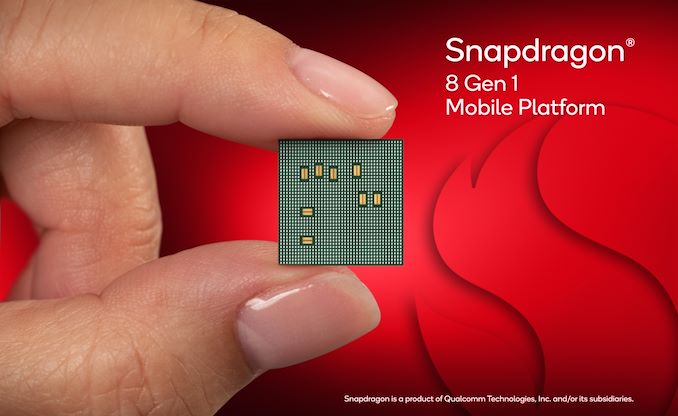The Snapdragon 8 Gen 1 Performance Preview: Sizing Up Cortex-X2
by Dr. Ian Cutress on December 14, 2021 8:00 AM ESTConclusionary Remarks: Arm v9 for Android
When we move through significant revisions of Arm’s architecture, up to v8 and now v9, it’s important to note that the new features defined in the ISA do not always fundamentally improve performance – it’s up to the microarchitecture teams to build the cores to the ISA specifications, and the implementation teams to enable the core in silicon with frequency and power efficiency. Accomplishing that requires a good process node, design technology co-optimization, and then partners that can execute by building the best devices for that processor.
Qualcomm’s target with the Snapdragon 8 Gen 1 is very clearly the 2022 Android Flagship smartphones. New cores, new graphics, enhanced machine learning capabilities, a step function in camera processing power, an integrated X65 modem, all built on Samsung’s 4nm process node technology. The flagship Android space is an area in which Qualcomm has been comfortable for a number of years, however the increased thermals of last generation’s Snapdragon S888 gave a number of analysts in the space a bit of a squeaky bum moment.
It’s hard to tell immediately in our small test if that still remains the case. Samsung’s 4nm node has improvements beyond the previous generation 5nm design, however Qualcomm’s presentational numbers were above and beyond those that Samsung provided, perhaps indicating that additional improvements both in architecture and implementation have led to those performance numbers.
Our testing shows +19% floating point performance on the X2 core, which is almost the +20% that Qualcomm quotes, but only +8% in integer, which is often the most quoted. We’re seeing power efficiency improvements for sure on the X2 core, with an overall efficiency improvement of 17%, but peak power has also increased, in part because some of our tests make use of the additional cache in the system. Our machine learning tests are +75% over the previous generation, although not the 4x numbers that Qualcomm states – we need to do more work here on power efficiency testing however. On the gaming side, our 'first run' numbers showcase some explosive gains in GPU throughput.
Although we’ve only done a few tests here, I would be remiss if I didn’t mention the elephant in the room: MediaTek. In the last month MediaTek announced a return to the high-end with a flagship processor of its own, using the same 1+3+4 configuration with slightly higher frequencies, more cache, and built on TSMC’s N4 process. Implementation here will be the key metric I feel, so how MediaTek has been able to optimize for TSMC N4 vs Qualcomm on Samsung 4nm is going to be analyzed. I should point out here that a processor is more than just the CPU cores, as we’ll see Adreno vs Mali on graphics, the different machine learning approaches, but also how the two companies approach 5G and connectivity, which has been one of Qualcomm’s most prominent strengths to date.
We look forward to testing the Qualcomm S8g1 in more detail in the New Year, as well as how many of the main smartphone OEMs choose Qualcomm for their flagship devices.












169 Comments
View All Comments
GeoffreyA - Wednesday, December 15, 2021 - link
Since about Kit Kat or so, the bytecode of an Android app is compiled to native code at install time. But doubtless C++ would still be faster because Java overdoes object-oriented style and dynamic allocation. C/C++ code can work in Android using the NDK, but it appears to be a nightmare getting it latched in. Sometimes I wonder what they were thinking when they picked Java as their language.Meteor2 - Friday, December 17, 2021 - link
They were thinking about the number of developers who could code it...TheinsanegamerN - Friday, December 17, 2021 - link
Developer support, ease of transition, and flexibility.Chaser - Tuesday, December 14, 2021 - link
Before, I used to care about these SOC improvements/benchmarks, etc. But I don't play games on smartphones. All I care about today is battery life improvements, not performance.Alistair - Tuesday, December 14, 2021 - link
That's why I switched to Apple. I get battery life and efficiency improvements, and CPU improvements. The only highlight for Snapdragon is GPU. CPU improvements are almost non-existent this year, again. Same for several years, they get farther and farther behind Apple in CPU.flyingpants265 - Thursday, December 16, 2021 - link
Yeah, but everything else about it sucks.Alistair - Saturday, December 18, 2021 - link
just browsing the web and using apps that are the same on all platforms, and doing it fasterKangal - Sunday, December 19, 2021 - link
Apple has a long history, that whenever their next chipset offers more efficiency, they counteract this by using a new (power hungry) feature.For instance, newer 5G modem, 120Hz screen, higher resolution, or more processing demand in their next software.
And at times, they even reduce the battery capacity. This saves weight off the phone, and they counteract this by adding other components like more cameras, or heavier glass construction.
All in all, the iPhones don't gain more battery life, they follow a general trend, and there are some outliers there (eg iPhone 6S+ and iPhone 13 Max).
TheinsanegamerN - Friday, December 17, 2021 - link
Budget phones like the moto g power annialate apple in real life battery benchmarks for a fraction of the price.Alistair - Tuesday, December 14, 2021 - link
I'll all in on Mediatek then, this was disappointing. Can't wait for Mediatek comparisons!